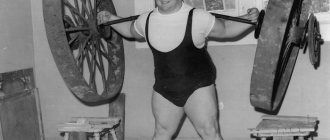- home
- 2021
- January
- The world record for pull-ups on the horizontal bar - how much is it and who set it?
Lee Shin-Yong
The world record for pull-ups on the bar without stopping was set in December 1994 by a seventy-year-old athlete from South Korea, Lee Shin-Yong. The man performed 612 pull-ups in a row over two hours and forty minutes. This is the highest single time score in the entire world that has not yet been broken.
There is also a record holder for the maximum number of strength exercises in 1 approach - this is Belarusian Maxim Trukhonovets, who performed 26 repetitions in March 2018. Let me remind you that a power-up is a type of pull-up, a power-out with two arms, in which at the top point of the movement the athlete goes over the bar with straight arms.
Russian record for pull-ups
In Russia, a world record for pull-ups was also set and entered into the Book of Records. This time the record holder was the Russian athlete Viktor Filippov, who performed 124 pull-ups in three minutes.
Victor Filippov
The previous world record for the maximum number of 100 pull-ups in three minutes, which Filippov broke, was set back in 1988 by a soldier from Vietnam.
Rules required to record a record
Did you think that you could just hang on the bar and do pull-ups? Of course not. There are some restrictions and rules for a world record to be recognized.
- Each time you lift your chin should be higher than the horizontal bar.
- The next pull-up will be counted only after the previous one has been completed by completely lowering and straightening the arms.
- Allowed to use breaks - choose a timeline and go! You can do the maximum right away and then rest, or you can do a little bit at a time with a little rest.
- You need to capture your result on video, from two angles (chin, and full visibility with the clock in the frame).
- Excluding leg assistance is a separate type and is considered separately.
- The crossbar must be flat and made of metal. The thickness is comfortable for a record holder.
- The crossbar should be higher than the level of straightened arms.
- The performer regulates the grip width independently.
So, if you decide to surpass yourself and achieve your moment of glory, then you will have to follow the rules described above. It’s impossible without them. Well? Could you set a new record? Or confirm the old one? Write your records in the comments.
Categories and time frames
As mentioned above, women and men compete in different categories, although their grips are the same, namely: - straight grip; - reverse grip.
Oddly enough, there are also time limits for which you need to pull yourself up the greatest number of times, taking into account breaks: - minutes - 1; 3; thirty; — clock – 1; 6; 12; 24.
I wonder, do you like these time regulations? Or would you bring something of your own? I also advise you to read the article about the 10 popular sports in Russia.
Weighted pull-up record
On May 4, 2022, a new Russian record for pull-ups in one minute with a 32-kilogram weight for 29 repetitions was registered in Sochi. The record holder was Viktor Filippov from Tomsk.
Viktor Filippov: weighted pull-ups
Filippov also holds the Russian record for the largest number of pull-ups with a weight of 16 kg in one approach. Victor performed 40 pull-ups.
The world record, listed in the Guinness Book of Records, was set in July 2011 by US Marine Corps veteran Stephen Proto. Stephen completed one pull-up with a weight of 93.53 kg. Proto set the second officially registered record in October 2014, when he performed 14 pull-ups in one minute with a weight of 100 feet.
Records not recorded in the Guinness Book
On one hand. This record was set by Sergei Smirnov, who did 22 pull-ups with his right arm, weighing 73 kilograms and height 185 centimeters. There is a video online where he was at a regional workout competition and pulled himself up the most.
In one approach. Jen Cairs set this record by performing 232 reps on the horizontal bar in 36 minutes. It is worth considering that he did not let go of the crossbar and did not stand on the ground to rest. I wonder how long it would take you to achieve a similar result?
What do you think of our compatriot?
Record for pull-ups in one day
The record holder for doing pull-ups within 24 hours is Andrew Shapiro, who performed 7,306 reps.
It is impossible not to mention the iron lady, repeated record holder among women in pull-ups, Australian Eva Clarke, who performed 3,737 pull-ups in one day in 2016. At that time the girl was 36 years old.
By the way, these same people set a world record in 12 hours. Andrew performed 5,742 pull-ups, the best result among men, and Eva performed 2,740 repetitions, the best result among the female half of the population. Also, American Andrew Shapiro managed to set a record for pull-ups in May 2016 for six hours, which totals 3515 repetitions.
Eva lives in the UAE, where all her world records were set. The girl set records for a charity event in Abu Dhabi, which raised more than fourteen thousand US dollars to donate to children from Brazil. The woman dedicated the records to her children, who always supported their mother in difficult times.
In addition, Eva is the Guinness record holder for the marathon with a backpack weighing forty feet in 4 hours 34 minutes and 42 seconds, as well as for push-ups on her fists - 70 push-ups in 1 minute.
Basic Rules
As in all other categories of sports, when performing pull-ups you need to follow the rules:
- Swinging is strictly prohibited. A pull-up done by inertia does not count. The exercise should only be performed using the strength of the participant's muscles.
- There should be no jerk when lifting.
- The exercise only counts when the chin is above the bar.
- The descent and ascent must be the same in duration.
- When ascending, exhale, and when descending, inhale.
- The body is always in a vertical position.
- Hanging is performed with an arched back. It is necessary to bend and cross your legs (this rule does not apply to athletes performing the exercise with a wide grip).
The types of grips are not much different. The main difference between them is that the distance between the hands can be medium, narrow, or wide. Athletes use the following types of coverage: direct, neutral, regular, and reverse.
For the average person, it is normal to do 15 pull-ups per minute with a wide grip and 20 times with a narrow or medium grip. For a non-professional athlete, 20–25 approaches per minute with a wide grip and 25–30 with a narrow and medium grip are considered the norm. Usually the exercises are done in several approaches. The break is 6–10 minutes, after which the student must continue further. In 15 minutes, a sports person will do 40 pull-ups on the bar with a wide grip and 60 with a medium or narrow grip. To keep your body in shape, you need to do 100 approaches per week, and this is the bare minimum.
At different times, various world records have been set for the total number of pull-ups, the number of pull-ups in 1 minute, 1 hour, 6 hours, 12 hours, 24 hours and so on. All of them were performed either with a direct grip, or with a reverse, wide, or narrow grip. To set world records for pull-ups, you need to practice hard. And you need to train for more than one week, month or even a year. You need to constantly increase the number of pull-ups: from the minimum value of 100, go to 150, and then to 200. You cannot put sudden stress on the body, so as not to harm yourself. The body must improve gradually, evenly. You need to have a complete plan for 1-2 weeks in advance. You need to know exactly which muscle group to pay more attention to.
The Swedish wall with a horizontal bar is the best exercise machine for pull-ups.
Types of grips
The safest exercises for the upper back[edit | edit code]
This is the safest exercise that works with natural biomechanics, not against it. This is very important because the back, if not trained correctly, is easily injured, and a healthy back is the basis of a healthy life. The lower back is often injured, mainly due to improper lifting technique. But no one has ever suffered a back injury from doing pull-ups.
When the legs are in the air, the lower back does not receive any external load - during the exercise the back remains in its natural position, maintaining the inherent curves of the body - the spinal erector muscles work.
Regular pull-ups work the muscle corset and protect your back from injury. Many powerlifters have an unnaturally developed outer deltoid due to all kinds of arm presses. Due to an imbalance in the development of the shoulder girdle, such athletes are susceptible to various injuries. Pull-ups strengthen the posterior deltoid muscle in the shoulder. By gradually adding pull-ups to your workout, you will in a short time get rid of unbalanced development of the shoulders and arms, thereby preventing various types of injuries. The correct technique will strengthen your joints, which other back exercises cannot do.
Types of competitions
There are 2 categories:
- Classic streetlifting . Here, parallel bars and pull-ups are performed with as much additional weight as possible per repetition. You can perform in one separate movement (any) or in a double event.
- Multi-repetition streetlifting . As the name suggests, the goal here is to perform as many reps as possible with a given additional weight. Weights used are 8, 16, 24, 32, 48 kg for men and 8, 12 and 16 kg for women. Similarly, you can perform in one movement or in a double event.
All participants are divided into categories according to age and weight (and, of course, gender). It is also worth noting that there are divisions with and without mandatory doping control.
Vladimir Turchinsky
Soviet and Russian athlete, entrepreneur and showman Vladimir Turchinsky, nicknamed Dynamite, who died in 2009 from a heart attack, was also mentioned as a record holder. Over the years of his sports career, he managed to move a Ruslan plane weighing 260 tons, win a tug-of-war with 30 participants, pull a double-decker bus weighing 20 tons 100 meters, and also hold an elephant weighing 3.5 tons in his arms. For all this, he became the owner of a diploma and a gold medal from the Guinness Book of Records.
“Hard” shoulders[edit | edit code]
Stiff Shoulders
All hanging exercises put stress on the arm joints, so it's important to know how to protect your shoulders and elbows from injury.
The shoulder joint is like a ball-and-socket joint—it has a ball-and-socket shape and allows for the greatest range of motion, from rotation to flexion. But the increased range of motion comes at the cost of decreased stability. If you relax your shoulders while hanging from a bar, the joint is stretched and held in place only by inflexible ligaments. Such actions not only cause damage to the ligaments, but also in some cases lead to partial or complete dislocation of the shoulder. It may not happen often, but it does happen, especially if the athlete has already been injured. Therefore, when doing pull-ups, you should tighten your muscles tightly, protecting the ligaments and avoiding unnatural bends in the elbows and shoulders.
Exercises in which the body hangs in the air, especially pull-ups with leg raises, are extremely effective, so it is important to master good technique from the very beginning of training. Keeping your shoulders stiff isn't that hard. To do this, you just need to lower your shoulder joints by five centimeters. Look at the picture - do you see the difference? This trick is easy to do if you tense your latissimus dorsi muscles. Keep your entire upper body tense during the exercise and you will succeed.
Common Mistakes
Errors when doing pull-ups on the horizontal bar in any style and technique are common among beginners, but they often lead to further growth of skill, although, strictly speaking, real mastery in this case is impossible to achieve.
And here are the most common problems:
- Excessive movements - the legs should be straight or bent and pulled up, but it is unacceptable to dangle them and the body should also have a minimum of mobility - all its energy is directed into the hands.
- Holding your breath may seem like it’s easier to do pull-ups, but in reality it also disrupts the functioning of the heart and provokes hypertension.
Execution Rules
There is no need to provide any documents to set a new world record for pull-ups. The main requirement is the mandatory recording of the execution of this record on video in several versions, one of which displays the position of the athlete in such a way that it is possible to unconditionally record the results of his pull-ups and a video recording of this record on stopwatches or other similar devices for measuring time, since the time allocated for record time plays a major role in such records.
When performing pull-ups to set a world record, there are special rules, compliance with which is mandatory for the commission to recognize the fact of setting a new world record.
- When performing a pull-up, the chin should be at the highest point (above the bar)
- A new repetition should be started from a position in which the body hangs freely with outstretched arms
The presence of rest breaks does not count towards the result, but the very fact of their presence can negatively affect the number of repetitions that the athlete will be able to complete in the allotted time. Also, repetitions performed using the legs do not count towards the record. Leg assistance is counted separately.
The Russian Vitaly Kulikov can boast of the best result in pull-ups using the legs, who managed to do 66 repetitions within one minute.
The location of the crossbar is also important. It must be exactly at arm's length of the athlete who must perform the approach, or not lower than this level. Even the material of the horizontal bar on which this record will be performed must be metal, but its diameter has not been established and can be anything.
Useful properties of pull-ups[edit | edit code]
Muscles involved (description)
Perhaps I dug too deep in the previous paragraph. Or maybe I just spent too much time alone thinking about push-ups and pull-ups. Or maybe both. Who knows? But whether you agree with my theory or not, there is no denying that pull-ups are underappreciated by modern athletes. When the torso is mentioned, everyone thinks of chest muscles, strong arms and broad shoulders. While these pushing muscles are certainly important, compared to the musculature of the upper back - the pulling muscles - they are just stifling muscles. The largest muscle in the body, the latissimus dorsi, originates from the armpits and, covering the lower corner of the shoulder blade, descends down to form a “wing.” Most of the back muscles—the trapezius, posterior deltoids, rhomboids, teres—are worked in pulling exercises, but virtually all the work is done by the latissimus dorsi. These muscles are not only large, but also amazingly responsive—as if their cells are programmed to grow larger when stimulated. Look at modern bodybuilders - their most impressive muscles are not on their legs or arms, but on their backs; many of these guys have latissimus dorsi muscles that look almost like wings. Even avid bodybuilders who find it incredibly difficult to add volume to their chests find that after working the latissimus dorsi muscles, their chests literally become larger before their eyes. It’s as if these muscles, powerful tools mastered by our ancestors, are in hibernation, but are ready to grow at any moment, as if by magic.
Unfortunately, modern back training programs include far from safe exercises with barbells and dumbbells, which increase the load on the lower back and spine, and this, in turn, leads to damage and stress. This is probably due to the wide variety of exercise machines - from horizontal and vertical rows to seated blocks. Why are they so popular? Yes, because exercises on machines are much easier to do! You can sit or even lie down and play the weight back and forth. Exercise machines make it easier to do exercises - there is no benefit from them until steroids are used. And guys on steroids don’t get stronger, they just get blown away in all directions, and they look like an absurd pile of muscles.
Forget about all the exercises you did in the gym - they are not needed. The fastest and, most importantly, safest way to develop your back is with modest pull-ups. This is the main exercise for the back, because nature itself has built the pull-up mechanism into the human body, and all you need to do is simply “wake up” it. In the modern world there are not many situations in which pull-ups can be used, but we cannot refuse such a rich genetic inheritance. All the pulling muscles are involved in the pull-up - every muscle is worked, and in a very short time your shoulders will become powerful and your fingers strong as steel.
Pull-ups build muscle and strengthen your fingers and hands, even if you don't do any special exercises. The rotator cuff receives its share of the payload. Moreover, pull-ups strengthen your abs and thighs - they receive an isometric load, because in ordinary life you rarely have to hang, lifting yourself off the ground. For beginners, the abs ache even more than the back muscles.











